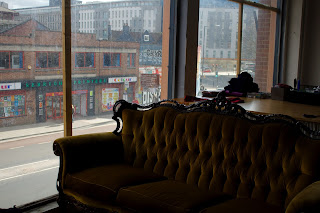Monday 29th February 2016
Today we had a contextual lesson on being sustainable and we were asked the question we've been asked a million times in science "what environmental impacts do I have? and what do I do that is environmentally friendly?"
My responses for the first question was:
.The use of electricity produced by fossil fuels
.Eating meat
.Plastic waste
My responses for the second question was:
.Recycling
.Using public transport - this is friendlier because instead of having 10/20 cars on the road, you have only one bus transporting people around.
.Re using materials such as plastic bags instead of buying more or using the material bags instead
Next we talked about how our photographic practice can affect the environment. Similar to many things, this has a positive and negative approach. For example photography can be used as a voice to show things like climate change, however the negatives to this are using the chemicals in the darkroom or the use of materials we use when printing.
4D evaluation
In the afternoon we had a session on IMovie. We were shown a showreel, which is a collection of images made into a short film and we were told to make one for our 4D element of our project. I really enjoyed this task as I enjoy film/editing film as well as photography. We were allowed to use either pictures or film we had taken during this project, I decided to use film because I feel it looks more effective. The film I used was a video from the Bristol trip we went on, it wasn't actually my film, but it was one of my friends Ryan's - me and my friends have a shared folder full of videos we take of each other and as I didn't take any film of that trip I decided to edit his film instead. The reason I didn't decide to use my own images to create a show reel was because I didn't really like the though of a show reel, I feel that if you're making a 'film' it should be of film. Just for me personally I prefer to do this. I used an upbeat song from the IMovie software called "yearbook" which I though fitted well with this film, as it was in an 'urban city' which is usually stereotyped with upbeat music. I thought my final outcome of this film was pretty good, if I say so myself. I really enjoyed making it and felt it was a fun task.
I'm analysing another students work for this subject as it will give me a chance to practice critical analysis. I've picked Ryan Trower's showreel to analyse which is a collection of images from our trip to Bristol. The positives to Ryan's work here is that there is some awesome photography that he has produced, he's progressing on the HDR in his images and the fact he is carrying on with something he's been taught is really good. The music is okay, but I feel that maybe it should've been a bit more upbeat as the images include a lot of graffiti and city like images so personally if it was me I would've added an upbeat urban song. I also feel that the images should be still instead of panning around the place, maybe if there was an upbeat song it would fit but for this sort of music I'd say stick to having them still.
My Video
Ryan's Video



























